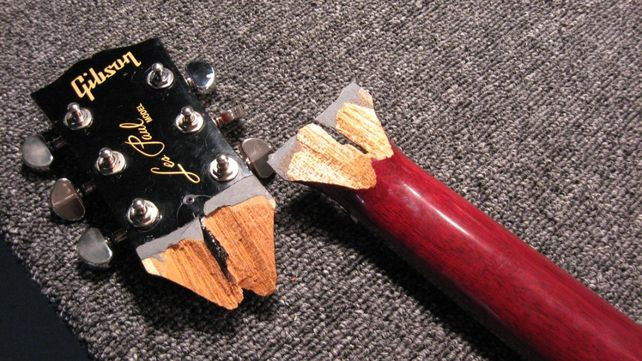I sanded this to 80 grit using leveling beams. Progress pictures not necessary...
It's important as you level a face to make sure that it is straight in all planes. That is to say, end to end along its length, across the short face (at multiple points) and also from corner to corner (to check for twist). Once I'm done sanding, I check these planes. Here's the longest:
It was all good.
Next it's time to prepare what will become the scarf joint at the headstock. Traditionally, necks are often made out of a single, thick piece of mahogany without a joint. However, they can be prone to this breakage as a result:
Here's a diagram illustrating why:
So, first I measure the angle of the headstock on my template (16 degrees):
Then I try to dial the same angle into my bandsaw:
I couldn't get enough angle on the table to cut it this way... but this way looks possible...
However, my little bandsaw can't get enough blade to make that cut:
So, nothing to do but smash it out using handsaws:
Yielding this:
Once these two are put together, you get one of my favourite moments in making the neck, when it actually starts to resemble something :]
You can see how the whole neck starts to look when placed next to the template:
The faces of the scarf joint are messy and need tidying, especially given the saws used to cut them. I had already made a jig for this part of the process. I copied the jig used by David Fletcher (epic LPJ build here).
The edges of the sloped section of the jig match the headstock angle and are first used as a guide for a long (number seven) plane to hog out the protruding material:
Ideally you should just use a plane for this step, but my tiny workshop makes it relatively difficult to get a comfortable planing position with a number seven. I decided to use abrasives to finish off the job, by running a sanding sledge on the jig:
Until we approach completion:
There's another ten minutes needed on the scarf joint faces, but they're very close to being done. Next up will be to build up the area around the heel of the guitar (where my mahogany is not thick enough - see the picture above with the template) and then to glue it all up.



































































